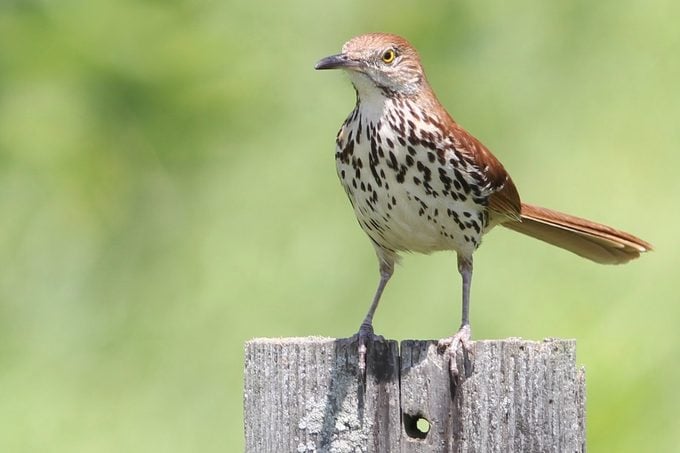Brown Thrasher: An Elusive, Musical Songbird
Updated: Jul. 10, 2024
The brown thrasher is an excellent mimic and sings more than 1,000 tunes. Learn how to spot these secretive songbirds.
On This Page
What Does a Brown Thrasher Look Like?

For a fairly large bird (nearly 12 inches), a brown thrasher is not that easy to spot. The adult brown thrasher’s most striking feature is its glowing yellow eyes. The bill is distinctive, too—long, with a slight downturn.
Birding experts Kenn and Kimberly Kaufman say, “The brown thrasher is a distant relative of the northern mockingbird and the gray catbird. Like those birds, the brown thrasher has a fairly long tail, thin bill and interesting voice, but its color pattern is completely different.”
Look for deep rufous browns on the head and back. Heavy brown streaking on the chest might suggest some kind of thrush or sparrow. The brown thrasher is sometimes mistaken for a wood thrush, but it has a longer tail and stripes—not round spots—on its chest.
Brown Thrasher Habitat

These elusive songbirds seek out dense thickets or tangled vegetation in the eastern United States. Thrashers spend most of their time in shrubbery. They may visit feeders that have dense cover nearby, or stop in to a backyard full of berry-laden shrubs.
What Do Brown Thrashers Eat?

Cover means everything to brown thrashers, so if you want to attract these birds to your yard, plant berry-producing shrubs that provide both food and shelter. They may visit feeders for seeds and nuts, provided you place them on or near the ground.
Brown thrashers also forage on the ground for insects buried in soil or leaf litter. As they walk, they make thrashing motions with their heads, tossing aside twigs or leaves that might be in the way of a meal.
Nesting Habits

Unlike mating pairs of many species, both males and females select a nest site, incubate the eggs and feed the young. Babies leave the nest fully feathered, sometimes within nine days of hatching, earlier than most related species.
Brown Thrasher Song
Bird sounds courtesy of the Cornell Lab of Ornithology

Most male songbirds have more than one song in their repertoire; these ditties help attract mates and scare away other males that may be trespassing. Brown thrashers have an entire catalog of tunes—they’re capable of singing more than 1,000 melodies.
“One afternoon I heard loud, boisterous singing, like a mockingbird’s song, but to my surprise it was a thrasher. Why would a thrasher sing like this? Are the two birds related?” asks Birds & Blooms reader Barbara Hart of Brevard, North Carolina.
Kenn and Kimberly say, “Yes, thrashers and mockingbirds belong to the same family. Brown thrashers are not such accomplished mimics as the mockingbirds, but they do work some imitations into their songs.
Usually a mockingbird will repeat each phrase of its song several times before switching to a new theme, while a brown thrasher will repeat each phrase just twice before going on to the next one. But, of course, birds don’t read the books, and they don’t always sing the way they’re supposed to sing.”
Next, learn all about bird songs: nature’s symphony.
Additional reporting by Emily Hannemann
About the Experts
Kenn and Kimberly Kaufman are the official bird experts for Birds & Blooms. They are the creators of the Kaufman Field Guide series and they lead birding trips all over the world.





















